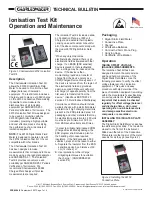
Unit 17. Millbrook Business Park, Sybron Way • Crowborough, East Sussex TN6 3JZ United Kingdom
Phone: 00 44 (0) 1892-665313, Fax: 00 44 (0) 1892-668838 • E-mail: [email protected], Internet: Charleswater.co.uk
PPE-5084.E
September 2007 Page 1 of 4
Figure 1. Charleswater 99152 Ionisation
Test Kit
Description
The Charleswater Ionisation Test Kit
allows the 99150 Digital Static Field
Meter to be used to monitor the offset
voltage (balance) of ionisation
equipment. The test kit also includes a
Charger used to place a ±1000V charge
on the 99153 Conductive Plate, making
it possible to also measure the
discharge time of air ionization
equipment per ANSI/ESD SP3.3
Periodic Verification of Air Ionizers. The
99152 Ionisation Test Kit was designed
to be used in conjunction with the
99150 Digital Static Field Meter
(included), providing a highly portable
and cost effective means of verifying
the performance of a wide variety of
ionization equipment.
NOTE:
The 99150 Digital Static Field
Meter is designed to operate only with
the 99152 Ionisation Test Kit. It is not
compatible with other brands.
The Charleswater Ionisation Test Kit
has been designed to make
measurements that correspond to those
made by using a charged plate analyzer
and ANSI/ESD S3.1. The Ionisation
Test Kit provides convenience and
portability per ANSI/ESD SP3.3 Periodic
Verification of Air Ionizers. We
recommend Charleswater’s 99096
Charged Plate Analyser if precise
measurements are required.
The Ionisation Test Kit includes a slide-
on Conductive Plate, a ±1000 volt
Charger and a durable thermoplastic
carrying case with custom cut-outs for
all of the above components along with
the model 99150 Digital Static Field
Meter.
“When any object becomes
electrostatically charged, there is an
electrostatic field associated with that
charge. If an ESDS [ESD sensitive]
device is placed in that electrostatic
field, a voltage may be induced on the
device. If the device is then
momentarily grounded, a transfer of
charge from the device occurs as a
CDM [Charged Device Model] event. If
the device is removed from the region of
the electrostatic field and grounded
again, a second CDM event will occur
as charge (of opposite polarity from the
first event) is transferred from the
device.” (Handbook ESD TR20.20
section 2.7.5 Field Induced Discharges)
Compliance verification should include
periodic checks with a static field meter
to determine if high charging material is
present in the ESD protected area. All
packaging and other materials that may
be electrostatic generative to 2,000 volts
must be kept a minimum of 30.5 cm
from ESD sensitive items at all times.
“In order to mitigate field-induced CDM
[Charged Device Model] damage, the
ESD program shall include a plan for
the handling of process-required
insulators. If the field exceeds 2,000
volts/inch, steps shall be taken to either:
A. Separate the insulator from the ESD-
sensitive device by a distance of 30
cm (12 inches); or
B. Use ionization or other charge
mitigating techniques to neutralize
the charge.” (ANSI/ESDS20.20
section 8.3)
Ionisation Test Kit
Operation and Maintenance
TECHNICAL BULLETIN
© 2007 CHARLESWATER LTD.
Packaging
1 Digital Static Field Meter
1 Conductive Plate
1 Charger
2 9V Alkaline Batteries
1 Cord with 2.5mm Mono Plug
1 Carrying Case
1 Certificate of Calibration
Operation
TAKING OFFSET VOLTAGE
(BALANCE) MEASUREMENTS
The Ionisation Test Kit has been
designed to match the compact size
and hand held convenience of the
Digital Static Field Meter. Use the
following procedure to verify the offset
voltage (balance) of air ionisation
equipment. This quick and easy
procedure will help determine if the
piece of ionisation equipment is working
within the manufacturer's specifications
or user requirements.
It is extremely
important that ionisers be checked
regularly for offset voltage (balance)
and discharge times. An ioniser
operating in an out-of-balance state
can damage sensitive electronic
componets or assemblies.
INSTALLING THE ISOLATED PLATE
ASSEMBLY
The Digital Static Field Meter’s case has
two slots along its slides. The top slot is
closest to the front of the instrument.
Slide down the tabs of the Conductive
Plate plate into the top slot of the meter
case as far as they go (see Figure 2).
Made in America
Figure 2. Installing the 99153
Conductive Plate






















